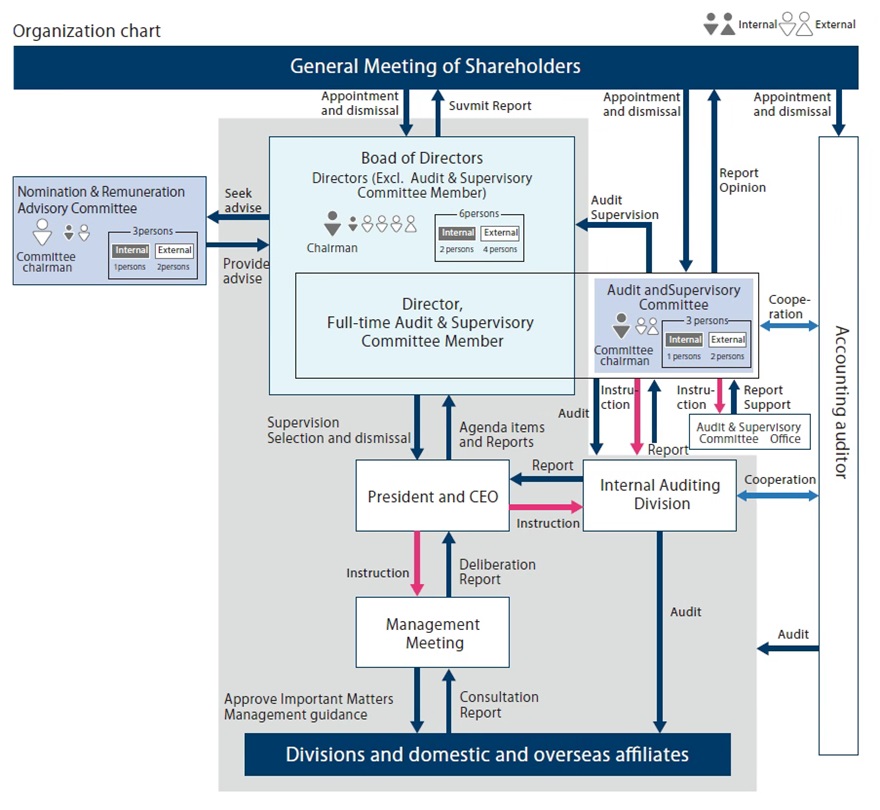Corporate governance structure
Basic Approach
The Company has strengthened the supervisory function of the Board of Directors by including Audit & Supervisory Committee Members, who are responsible for auditing the execution of duties by Directors, among the members of the Board of Directors, thereby further enhancing corporate governance by further strengthening the monitoring system. The Board of Directors broadly delegates decision-making authority on business operations to Directors. Through these measures, the Company separates the business execution function from the supervisory function, and expedites management decision-making, in order to further enhance its corporate value.
Corporate Governance Structure
Board of Directors
In accordance with the Board of Directors Regulations, the Board of Directors holds regular meetings once a month and extraordinary meetings as necessary to make decisions on important management matters and supervise business execution.
Currently, there are six Directors (excluding Directors who are Audit & Supervisory Committee Members) and three Directors who are Audit & Supervisory Committee Members, six of whom are Outside Directors, and all six have been registered with the financial instruments exchange as Independent Officer
Audit & Supervisory Committee
The Audit & Supervisory Committee, consisting of three Directors who are Audit & Supervisory Committee Members, discusses important matters concerning auditing. The Audit & Supervisory Committee, chaired by a Director who is a full-time Audit & Supervisory Committee Member, meets once a month in principle, and holds extraordinary meetings as necessary.
Currently, the Audit & Supervisory Committee consists of three Directors who are Audit & Supervisory Committee Members, two of whom are Outside Directors, and both have been registered with the financial instruments exchange as Independent Officer.
Management Meeting
The Management Meeting deliberates and decides on important matters concerning corporate management, including management policies and management strategies of the Group. To ensure enhanced deliberation and proper decision-making, particularly important matters are discussed thoroughly at the Management Meeting before being submitted to the Board of Directors. The Meeting shall be held once a month and shall be attended by Directors who are full-time Audit & Supervisory Committee Members.
Executive Officer System
The Company has introduced an Executive Officer System in order to divide the roles of management supervision and business execution functions.
Executive Officers is currently six, including two who concurrently serve as a Director.
Accounting Audit
The Company is audited by KPMG AZSA LLC.
Audit & Supervisory Division
The company has established an Audit & Supervisory Division and stationed Audit & Supervisory Committee staff within it to assist in the duties of the Audit & Supervisory Division.
Internal Auditing Division
The Internal Auditing Division, an independent and dedicated organization provides guidance and advice to improve management efficiency as a corporate group and establish a system to fulfill our social responsibilities.
The three audit functions, including the Audit & Supervisory Committee, the Internal Auditing Division, and the accounting audit by the auditing firm, meet as needed to share information and conduct effective and efficient audits.
Nomination & Remuneration Advisory Committee
With regard to the nomination and remuneration of Directors, the Company has established a voluntary Nomination & Remuneration Advisory Committee, chaired by an independent Outside Director, as an advisory body to the Board of Directors, as it is necessary to strengthen the independence and objectivity, and accountability of the Board of Directors’ functions.
Currently, the Nomination & Remuneration Advisory Committee consists of four members, three of whom are Outside Directors, and the majority of members are Outside Directors to enhance the independence and objectivity of the Committee.



